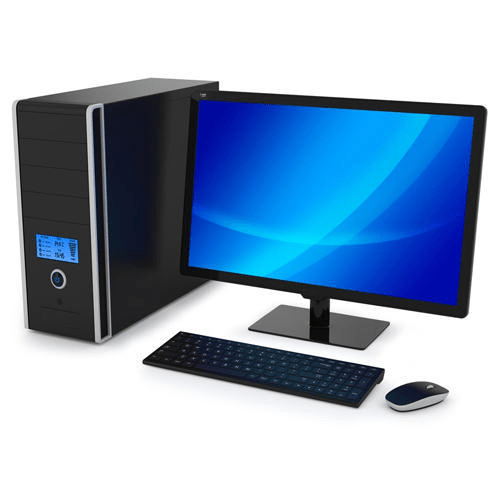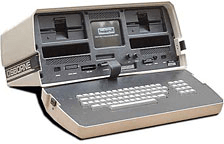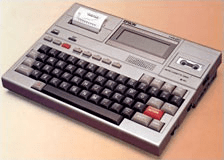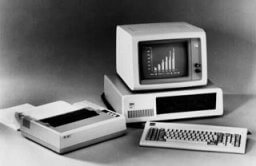What is PC
PC stands for personal computer that allows the user to perform certain functions that can reduce the load of daily tasks and be effectively used by an individual. Ed Roberts used the term personal computer for the first time. He launched the MITS Altair 8800, for which he used the term personal computer. A personal computer can be used by a single individual and does not require multiple users to perform various tasks. The design of the personal computer uses microprocessors enabling the developers to set up the entire processing unit of the system onto a single chip.

Several essentials’ components for personal computers include a monitor, mouse, keyboard, and CPU. The system can perform limited tasks, but they are usually connected to an internet network to increase its functionality. It has various ports that allow the user to connect external devices such as printers, scanners, or webcams. The user can increase the storage and performance of the system by using additional hard drives, RAMs, and graphic cards.
Generally, the term personal computer or PC is used for systems designed by IBM or compatible with it. However, Apple Macintosh has also been considered a personal computer because they also fulfill the given criteria, but they are usually referred to as a mac.
Personal Computers enable the user to store data in spreadsheets, type documents, and play games, and the user can see and listen to various video and audio files. Using a personal computer, the user can create personalized applications and databases.
Still, when the system is connected to the internet, the user can perform additional tasks such as surfing the internet, downloading or uploading files on the internet, sending and managing emails, and sending instant messages worldwide using social media applications. The user can set up a network of several personal computers to transfer data among those computers only. Depending upon the size of the personal computers, they can be classified into desktop, laptop, microcomputers, tablets, or handheld personal computers. These gadgets surround us and have become an indispensable part of our lives.
Components required to build a Personal Computer
- Motherboard
- Power Supply
- Drives/ writers
- Memory
And several peripheral devices can be used to input the data and display the output.
In modern times, systems were not always this compact, user-friendly, and cost-effective. When the first computer was made, it could only be afforded by large organizations or universities. In the mid-1960s and 1970, it almost required a whole room to set up a computer system. Multiple users worked simultaneously to perform a single task. It only took a decade to develop compact personal computers that individual households could afford. IBM developed its first personal computers in 1981. The system quickly became popular in the market.
Benefits of Personal Computers
Personal Computers have become an essential part of our daily life. They are used to perform both personal and professional tasks. They are used in various fields. It has increased the efficiency of performing several tasks by several times. It saves the time, effort, and money of the user.
Education: They are used to educate people. Nowadays, every household, school, and the university are equipped with personal computers. They are used to performing several tasks, such as managing attendance. The user can access the internet on personal computers and refer to multiple resources to learn a subject.
During the COVID pandemic, when physically attending the school was not possible, the kit was only because of personal computers that we could continue the student's studies. Every task was performed using personal computers. The teacher used to teach using video conferencing, assigned assignments, and even held examinations and all was possible because of personal computers. They also provide us access to resources around the globe. Thus, using personal computers, the user can gain knowledge of different countries and cultures. It allows users to use various software programs that help users perform specific tasks such as video or photo editing. Several skills can be learned using the PC.
Entertainment: Along with performing and simplifying tasks. The personal computer provides us with multiple options for recreation and entertainment. The user can play multimedia files on the personal computer using software like the VLC media player. The user can connect to multiple people across the globe through the internet. They can play multiplayer games together and compete with each other and other players worldwide no matter how far they are located. The user can also play single-player games, and there are some preinstalled games. The user can watch movies, play songs, and various other audio files. The user can also surf through online platforms, and the user can also download the videos and watch them according to his schedule, unlike the televisions where each program has a fixed broadcast time.
Communication: The personal computer allows users to connect and communicate with other users across the globe. The user just needs to connect the personal computer to a network to enable communication between the computers connected to it. The user can make voice calls using the internet using various applications such as WhatsApp.
The user can also communicate through emails. It is also possible to make video calls on personal computers. Several social media websites can be accessed using personal computers; users can use these social media websites to share their thoughts throughout the globe. They also provide the feature of instant messages. While the pandemic, they played an important role in maintaining the communication while everybody was locked in their homes. They were used to manage tasks between various employees; it allowed employees the users to share resources and synchronize the task at hand.
The employee can even add comments to make the project more understandable. This comparatively reduces the usage of mobile phones while certain tasks still require or are more efficient with personal computers. The user can also communicate with the personal computer itself using a voice assistant. They also allow the user to communicate through other machines, and the user can now control various electrical appliances from anywhere using your personal computer and an internet connection.
Information: The modern age is also known as the age of information, and for that, huge credit goes to personal computers. Personal computers also make it possible to use the internet by everyone. The internet made it possible to share and gather information effectively. Using personal computers to access the internet, users can access all the information. The user can either use a search engine or type a specific website URL. The user can refer to research that is taking place around the globe. There are countless resources providing information about numerous skills. The user can also read digital books and encyclopedias to provide you with knowledge about any subject. The user can also join a community where they can discuss specific subjects of interest.
Disadvantages of Using Personal Computers
There are various limitations of PC, such are as follows:
Physical Side Effects: Personal computers have greatly reduced physical labor requirements. This also has reduced the physical activities that are essential for the body. The user needs to sit on a chair when using a personal computer for anyone who has to spend most of his time sitting on a chair to use the computer. This can cause a lot of strain on the body. It causes several issues lie backaches, neck soreness, tight hamstrings, or pain in the wrist. It is also responsible for causing strain in the eyes, and using too many computers can also affect your eyesight. It is observed that users that are too indulged with their PCs are prone to all these health conditions.
Internet Addiction: It has increased the usage of the internet. The use of the internet has increased so much in the past years, especially among the younger generations, that it is almost like people are addicted to their personal computers. They spend most of their time surfing the internet. It is common for young generations to play games on their personal computers for hours. The users prefer to spend time on social media connecting to people far away who have lost the connection with their family and friends. They find it easier to share those thoughts with their friends on social media. This has increased the risk of depression and anxiety among the youth. People addicted to the internet have a constant urge to the internet. This addiction has exponentially increased with the introduction of personal computers. This largely affects the efficiency of a person.
History of Personal Computer
Though the first computer was built by organizations such as Microsoft and IBM, neither of these companies developed the first personal computer. However, Microsoft first tried to build the first personal computer. In 1975, the kits computer was launched; they were the first personal computers. They came in parts and can be easily assembled similarly to LEGO pieces. The kit computer was named IMSAI 8080, followed by MITS Altair 8800. That same year development was done in various fields. Paul Allen and Bill Gates designed the first compiler for Altair and established Microsoft. MOS technology developed the Z-80 processors. In the year 1976, Wozniak and Steve jobs together developed Apple's first and last kit computer, the Apple I. The user is only required to add a keyboard and insert a motherboard to the system to make it operational.
Electric Pencil was the first program that allowed the user to process word documents. This software was developed in the same year. Shugart developed the floppy drive; it allowed the user to store and easily transfer the data. This device revolutionized the concept of the personal computer.
In 1997, the first color personal computer Apple II was launched by Apple. It was a major milestone in the industry. It supported a floppy drive and was equipped with expansion slots. After the word processor, the first electronic spreadsheet was developed by Dan Bricklin and Bon Frankston. It became very popular among users. This was the first step that enabled the user to use the personal computer to perform business operations.
The introduction of the database in 1979; made it easier to perform business using personal computers. It enabled the user to easily store the data and manage it. Hayes introduced the 300-bps modem; this device allowed the user to establish a connection using the telephone lines. The first 16-bit system was developed by the Texas Instrument. Apple III was equipped with 192 KB of Random Access Memory; it was equipped with a hard drive with a maximum size of 5MB. By 1980 there were almost one million personal computers in the US itself.

The first portable computer was developed by Adam Osborne in 1981. It had a small display. It was equipped with a 5-inch display and two floppy drives to read and write the data. This system came with many preinstalled software that enabled the system to perform various functions.

In the same year, Epson developed the first laptop. It was equipped with an LCD screen and a keyword with 4 lines and each line containing 20 different characters. It used a microcassette for storing the data in the system.

The IBM Personal Computers

IBM PC was released in 1981, and it was a major incident in the industry. It was equipped with two drives and multiple expansion slots and had at least 16KB of Random Access Memory. Initially, the IBM PC exclusively belonged to the IBM organization only, but Microsoft was able to convince that the PC-DOS framework should not belong to IBM. This decreased the influence of IBM on the personal computer industry as it allowed the introduction of more organizations in the industry. It allowed the cloning of personal computers. The demand for personal computers significantly increased.
By the year 1982, there were more than 10 million personal computers in the United States only. IBM architecture became standard for the personal computer. The Blue industry had significant control over the computer industry. Apple developed the first consumer machine that had a specially designed user interface. It was very expensive, and therefore most the businessman was not able to purchase it. Apple introduced its Macintosh system, and this model was comparatively cheaper than the LISA. The first 32-bit computer was launched in 1986 by Compaq; it significantly increased the personal computer's speed. The speed of this PC was almost equal to that of a mainframe computer.
In 1994, personal computers were extensively being used for gaming. It became very popular among users. Some of the popular games were Magic Carpet, Theme Park, and Alone in the Dark 2.
In 1995, The Apple Mac was equipped with PowerPC 604 that could perform multiprocessing. IN some systems, four processors were working together. These personal computers were called quad-processor systems. It was the first time when the licensed Mac clone was launched. DayStar Digital; was a powerful computer that used the dual-processor Power Macs and was equipped with Mac operating system.
The company purchased NeXT in 1996. The licensed clone caused a huge loss to Apple, and it was forced to bring back Steve Jobs. Apple aimed to end the cloning, which cost them the most profitable part of the business. It shipped the Power Mac G3 in various models such as desktops, laptops, and all-in-one versions. Apple became the second most successful company for producing build-to-order computers. The most successful company was Dell. In 1998, Intel introduced the Celeron CPU, which was cost-efficient.
In 1999, Apple launched a new generation of iMac personal computers, and they were called the PowerBook; they had a USB port. These personal computers were the most powerful personal computer, and export restrictions were implemented on them.
Apple launched the most powerful operating system, Mac OS X, in 2001. it was mostly dependent on the Mac OS 9 for the running software. In 2001, Apple launched iMac G4. This was a powerful machine with a flat-screen display that made it to the cover page of Time magazine. After that, continuous developments have been made, and various new companies have launched various models of personal computers fitting the user's needs.
Nowadays, personal computers can be classified into Mac and PCs. The personal computers that Apple develops are called Macintoshes or Mac in short. No matter the organization developing the PC, it must follow the basic principle that is it should be equipped with a microprocessor, and a single user should be able to completely handle the system. Based on the usage, many variants of personal computers are available in the market.
What are Green Personal Computers?
The use of personal computers has significantly increased. It has also increased their effect on the environment. To reduce that effect, organizations have developed green personal computers. These computers require relatively less energy to operate, and they also allow the user to put the system in sleep mode and allow the user to perform some system operations in the background. They minimize the power consumption and are more energy-efficient than normal personal computers.
It provides users with certain features that allow them to control their power consumption. They are made up of environmentally friendly materials. Many organizations are especially focused on building greener personal computers. They aim to ensure that they can deploy effective computing systems in the green personal computers. This has drastically reduced the energy consumption in the industry. Green personal computers leave a very small amount of carbon footprint behind. For the past few years, the awareness regarding green computers has significantly increased. They reduce the cost of operation by saving energy.
Furthermore, this saves a lot of money for the organization. They are very beneficial in industries that require a very large number of personal computers. Therefore, they are beneficial for big It cooperates. Green personal computers are quickly replacing normal personal computers.
Ways to make your Personal Computer Greener
Activate the power-saving mode of your system: These features allow the user to reduce the energy consumption as it performs a certain task in the background while the screen is closed. It automatically goes to hibernation when the computer is not in use for a certain time.
Reduce the size of the system: The smaller the size of the personal computer, the lesser the material required to make it. This saves material used to build personal computers.
Multi-core Processors: Using them allows the user to perform multiple tasks simultaneously, which is necessary to save energy as it reduces the time for performing the tasks.
Efficient Power Supply: The user can determine the power supply of the personal computer. When developing a green personal computer, the user should try to achieve 80 plus power supply.